Lesson 8: Formatting Text
/en/word2013/text-basics/content/
Introduction
Formatted text can draw the reader's attention to specific parts of a document and emphasize important information. In Word, you have several options for adjusting the font of your text, including size, color, and inserting special symbols. You can also adjust the alignment of the text to change how it is displayed on the page.
To change the font:
By default, the font of each new document is set to Calibri. However, Word provides many other fonts you can use to customize text and titles.
- Select the text you want to modify.
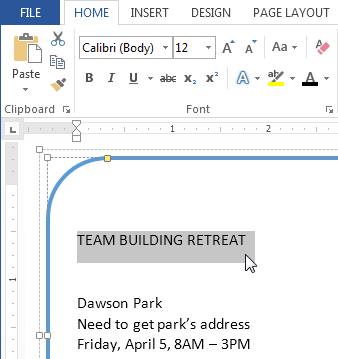 Selecting text to modify
Selecting text to modify - On the Home tab, click the drop-down arrow next to the Font box. A menu of font styles will appear.
- Move the mouse over the various font styles. A live preview of the font will appear in the document. Select the font style you want to use.
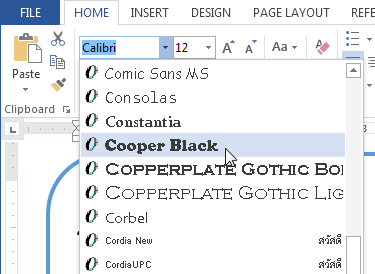 Changing the font style
Changing the font style - The font will change in the document.
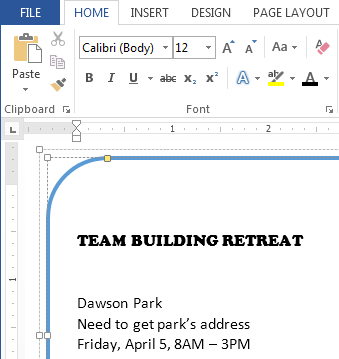 The new font style
The new font style
When creating a professional document or a document that contains multiple paragraphs, you'll want to select a font that's easy to read. Along with Calibri, standard reading fonts include Cambria, Times New Roman, and Arial.
To change the font size:
- Select the text you want to modify.
 Selecting text to modify
Selecting text to modify - Select the desired font size formatting option:
- Font size drop-down arrow: On the Home tab, click the Font size drop-down arrow. A menu of font sizes will appear. When you move the mouse over the various font sizes, a live preview of the font size will appear in the document.
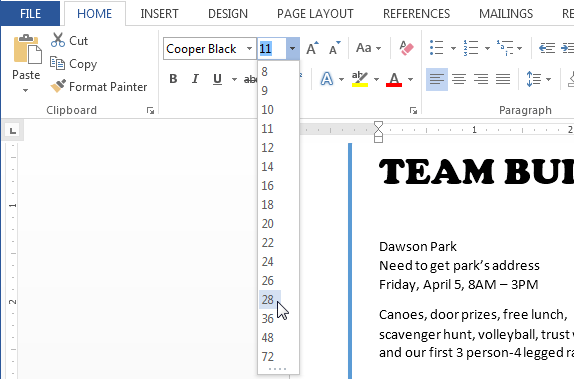 Selecting a font size
Selecting a font size - Font size box: When the font size you need is not available in the Font size drop-down arrow, you can click the Font size box and type the desired font size, then press Enter.
 Entering a font size in the Font box
Entering a font size in the Font box - Grow and shrink font commands: Click the Grow Font or Shrink Font commands to change the font size.
 The Grow Font and Shrink Font commands
The Grow Font and Shrink Font commands
- The font size will change in the document.
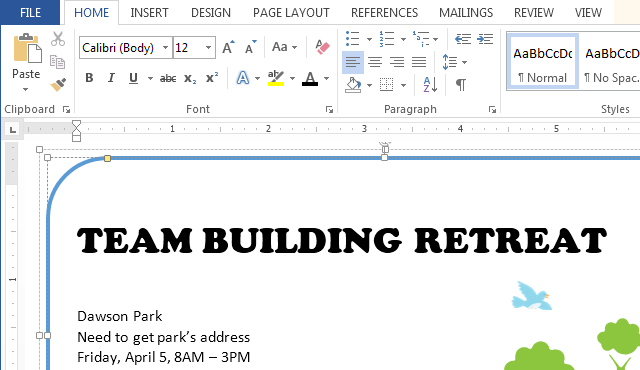 The new font size
The new font size
To change the font color:
- Select the text you want to modify.
 Selecting text to modify
Selecting text to modify - On the Home tab, click the Font Color drop-down arrow. The Font Color menu appears.
- Move the mouse over the various font colors. A live preview of the color will appear in the document.
 Changing the font color
Changing the font color - Select the font color you want to use. The font color will change in the document.
 The new font color
The new font color
Your color choices aren't limited to the drop-down menu that appears. Select More Colors... at the bottom of the menu to access the Colors dialog box. Choose the color you want, then click OK.
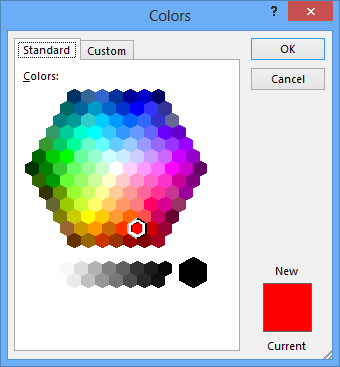 The Colors dialog box
The Colors dialog boxTo highlight text:
Highlighting can be a useful tool for marking important text in your document.
- Select the text you want to highlight.
 Selecting text to highlight
Selecting text to highlight - From the Home tab, click the Text Highlight Color drop-down arrow. The Highlight Color menu appears.
 Choosing a highlight color
Choosing a highlight color - Select the desired highlight color. The selected text will then be highlighted in the document.
 The highlighted text
The highlighted text
To remove highlighting, select the highlighted text, then click the Text Highlight Color drop-down arrow. Select No Color from the drop-down menu.
 Removing highlighting
Removing highlightingIf you need to highlight several lines of text, changing the mouse into a highlighter may be a helpful alternative to selecting and highlighting individual lines. Click the Text Highlight Color command, and the cursor changes into a highlighter  . You can then click, hold, and drag the highlighter over the lines you want to highlight.
. You can then click, hold, and drag the highlighter over the lines you want to highlight.
To use the Bold, Italic, and Underline commands:
The Bold, Italic, and Underline commands can be used to help draw attention to important words or phrases.
- Select the text you want to modify.
 Selecting text to modify
Selecting text to modify - On the Home tab, click the Bold (B), Italic (I), or Underline (U) command in the Font group. In our example, we'll click Bold.
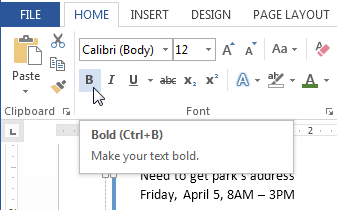 Making text bold
Making text bold - The selected text will be modified in the document.
 The bolded text
The bolded text
To change the text case:
When you need to quickly change text case, you can use the Change Case command instead of deleting and retyping text.
- Select the text you want to modify.
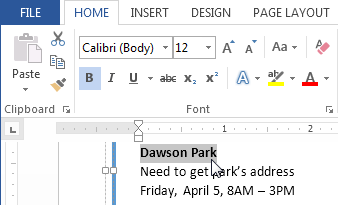 Selecting text to modify
Selecting text to modify - On the Home tab, click the Change Case command in the Font group.
- A drop-down menu will appear. Select the desired case option from the menu.
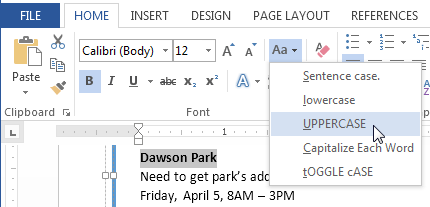 Changing the text case
Changing the text case - The text case will be changed in the document.
 The new text case
The new text case
To change text alignment:
By default, Word aligns text to the left margin in new documents. However, there may be times when you want to adjust text alignment to the center or right.
- Select the text you want to modify.
- On the Home tab, select one of the four alignment options from the Paragraph group.
 Paragraph alignment commands
Paragraph alignment commands
Click the arrows in the slideshow below to learn more about the four text alignment options.

Align Text Left: This aligns all selected text to the left margin. The Align Text Left command is the most common alignment and is selected by default when a new document is created.

Center: This aligns text an equal distance from the left and right margins.

Align Text Right: This aligns all selected text to the right margin.
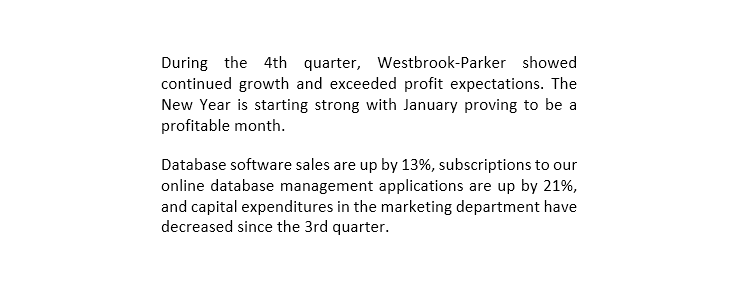
Justify: Justified text is equal on both sides. It lines up equally to the right and left margins. Many newspapers and magazines use full justification.
You can use Word's convenient Set as Default feature to save all of the formatting changes you've made and automatically apply them to new documents. To learn how to do this, read our article on Changing Your Default Settings in Word.
Symbols
Sometimes you may find that you need to add a symbol to your text, such as the Copyright symbol ©. Word offers a collection of symbols for currency, languages, mathematics, and more.
 Symbols collection
Symbols collection
To insert a symbol:
- Place the insertion point in the location where you want to insert a symbol.
 Placing the insertion point
Placing the insertion point - On the Insert tab, click the Symbol drop-down arrow. A menu of symbols will appear.
- Select the desired symbol.
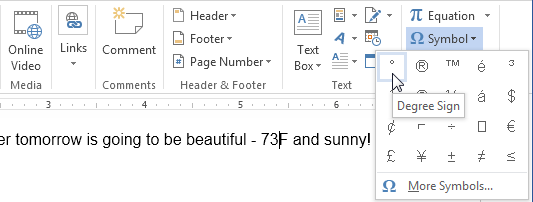 Selecting a symbol
Selecting a symbol - The symbol will appear in your document.
 The inserted symbol
The inserted symbol
If you don't see the symbol you're looking for, click More Symbols... to open the Symbol dialog box. Locate and select the desired symbol, then click Insert.
 Symbol dialog box
Symbol dialog box
Challenge!
- Open an existing Word 2013 document. If you want, you can use our practice document.
- Change the font style of some text.
- Change the font size of some text. If you are using the example, try changing the font size of the title.
- Change the font color of some text. If you are using the example, change the color of the park's name.
- Highlight some text.
- Try bolding, italicizing, or underlining some text.
- Change the case of some text. If you are using the example, change the case of the title.
- Center align some text.
- Insert a symbol in the text. If you are using the example, insert the registered trademark symbol ® after Sullie's Subs.
/en/word2013/page-layout/content/


 Selecting text to modify
Selecting text to modify Changing the font style
Changing the font style The new font style
The new font style Selecting text to modify
Selecting text to modify Selecting a font size
Selecting a font size Entering a font size in the Font box
Entering a font size in the Font box The Grow Font and Shrink Font commands
The Grow Font and Shrink Font commands The new font size
The new font size Selecting text to modify
Selecting text to modify Changing the font color
Changing the font color The new font color
The new font color The Colors dialog box
The Colors dialog box Selecting text to highlight
Selecting text to highlight Choosing a highlight color
Choosing a highlight color The highlighted text
The highlighted text Removing highlighting
Removing highlighting . You can then click, hold, and drag the highlighter over the lines you want to highlight.
. You can then click, hold, and drag the highlighter over the lines you want to highlight. Selecting text to modify
Selecting text to modify Making text bold
Making text bold The bolded text
The bolded text Selecting text to modify
Selecting text to modify Changing the text case
Changing the text case The new text case
The new text case Paragraph alignment commands
Paragraph alignment commands Symbols collection
Symbols collection Placing the insertion point
Placing the insertion point Selecting a symbol
Selecting a symbol The inserted symbol
The inserted symbol Symbol dialog box
Symbol dialog box